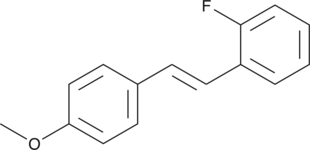Description
A metabolite and degradation product of the pesticide DDT; accumulates in various fish and sediment surrounding a DDT manufacturing plant; inhibits estrogen binding to rtERs (IC50 = 8 µM); induces concentration-dependent secretion of estradiol by granulosa and theca cell co-cultures isolated from porcine ovarian follicles; induces concentration-dependent secretion of estradiol by granulosa and theca cell co-cultures isolated from porcine ovarian follicles; decreases ATP levels, the proportion of sperm with high mitochondrial membrane potential, and motility of human sperm in vitro from 50-100 µM,
Formal name: 1,1′-(2,2-dichloroethenylidene)bis[4-chloro-benzene]
Synonyms: p,p’-Dichlorodiphenyldichloroethylene|4,4′-DDE|4,4′-Dichlorodiphenyldichloroethylene|NSC 1153
Molecular weight: 318
CAS: 72-55-9
Purity: ≥98%
Formulation: A solid
Product Type|Biochemicals|Pesticides||Product Type|Biochemicals|Receptor Pharmacology||Product Type|Biochemicals|Xenobiotic Metabolites||Research Area|Endocrinology & Metabolism|Hormones & Receptors|Estrogens & Progestins||Research Area|Endocrinology & Metabolism|Reproductive Biology||Research Area|Toxicology|Cell Health & Viability|Mitochondrial (dys)Function||Research Area|Toxicology|Drug Metabolism||Research Area|Toxicology|Environmental|Endocrine Disruption||Research Area|Toxicology|Environmental|Steroids



